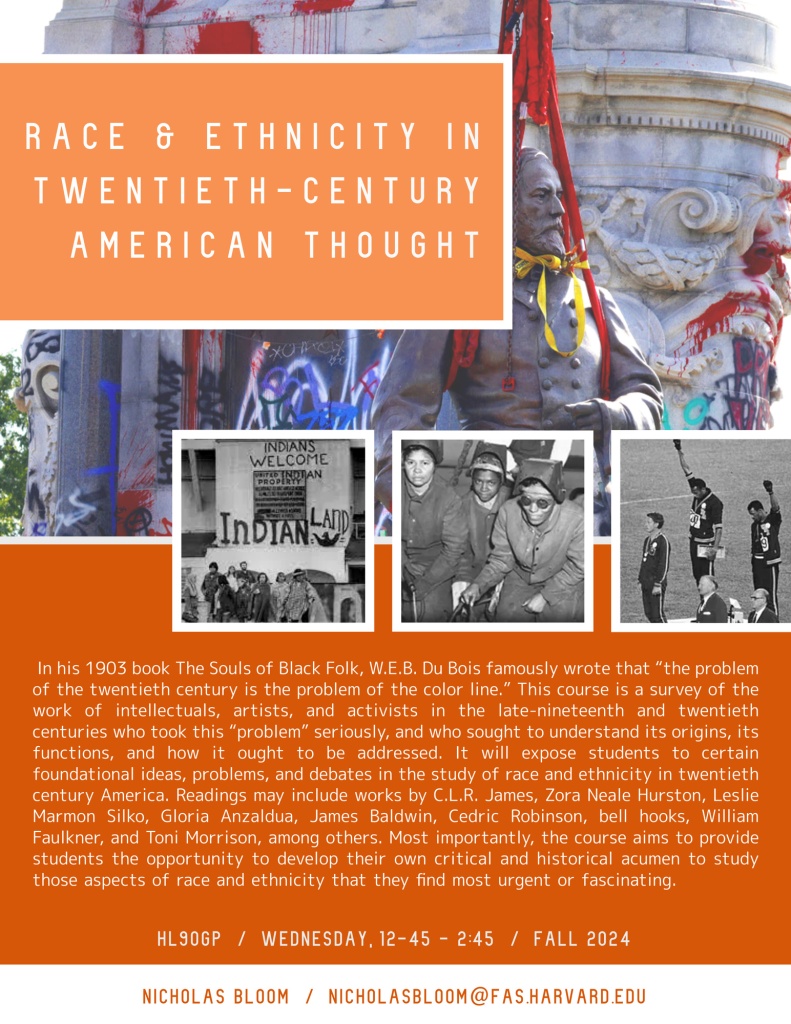We’ve got lots of new HL90s coming this fall, including Nick Bloom’s “Race & Ethnicity in Twentieth-Century American Thought,” Wednesday 12:45-2:45.

What inspired you to teach this class?
This class is inspired by a desire to introduce students to the incredibly diverse and powerful ways that people in and beyond the United States have analyzed, critiqued, reimagined, and/or sought to transform structures of race and ethnicity in the twentieth century. In my experience, to the extent that students have received a background on this subject, it is typically through the lens of a few important flash points (i.e. the Civil War and the Civil Rights movement) and a few important figures (Du Bois, King, Malcolm X, Morrison). All of these figures and and flash points are extremely important, but we do a disservice to not only the history of how race and ethnicity have functioned in the twentieth century, but also to the history of the ways that people have critiqued and resisted dominant ideas of race and ethnicity, when we limit our understanding of these things to just a few moments/people. Also, the texts we will be reading in this class are not only brilliant critiques of race and ethnicity, but are more broadly speaking some of the most important tracts of political and cultural thought authored in the twentieth century West, and I look forward to introducing students to some of these texts, and seeing what they do with them!
Any texts you’re especially looking forward to sharing with students?
One book that we will read next semester that I am really excited about is “American” in the broader sense of the term, not written in or about the US: the Trinidadian writer C.L.R. James’ Beyond a Boundary. James is one of the most important thinkers of the twentieth century, most famous for his history of the Haitian Revolution, The Black Jacobins. Beyond a Boundary is a history of the sport of cricket in the Caribbean, which may at first seem like a less serious book than something like Black Jacobins. However, James brilliantly weaves together memoir, cultural analysis, history, and beautifully poetic writing to create one of the most brilliant critiques of race and class ever written, with applications for the United States and beyond. Two other texts I am also especially excited to teach are Pueblo writer Leslie Marmon Silko’s Ceremony and Zora Neale Hurston’s novel Moses, Man of the Mountain.
What’s something surprising students might not know about this topic?
I think the history of race and ethnicity in the United States, and especially the history of the way that people have thought about and critiqued race and ethnicity, is often taught with a distinctly nationalist and progressive framework: i.e., with the idea that people of color have consistently sought to become more and more included within the dominant framework of US citizenship, and the US has gradually become more inclusive over time. I think this class will disrupt this idea. At various times, indigenous, Black, and immigrant peoples have sought political and cultural futures beyond or against the framework of the United States, and in turn, the United States has been anything but progressive in the way it has dealt with structures of race and ethnicity.
What kind of assignments can students expect?
I like to have students draw upon two primary texts in order to analyze one specific broader theoretical/historical question, ultimately developing their own analysis. In this class, I am especially interested to have students use older texts, from the earlier part of the twentieth century, to analyze more contemporary specific issues, and to develop their own ideas how these older texts’ frameworks/ideas do or do not still apply to a specific, more contemporary problem that may be of interest to them.
What does your class help us understand about the present?
Race and ethnicity continue to be a primary way that our societies are structured in the United States and beyond. Their power derives from the fact that too often these structures are seen as “natural” or “ancient,” when in fact they developed fairly recently in the scope of human history, and they are changing constantly. I think this class can only help students to both understand how existing relations of power around race/ethnicity have come to be, and also to see them as something they have some power over in terms of rethinking and transforming them in their lifetimes.
You mentioned cricket–are you a sports fan?
I love talking and learning about sports and popular music, and I love learning from students about popular culture things that I don’t know about. These things can both bring levity to discussion, and they also add richness to the content of what we are doing, and I always encourage some level of this kind of seemingly “tangential” discussion.
How can students learn more?
You can read more on the Canvas site or send me an email.

You must be logged in to post a comment.